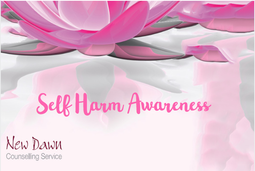 "The phrase “self-harming behavior” may call up images of troubled teenagers with cuts on their arms. But self-injury can occur for people of any age, in children, adolescents and adults, whether male or female. This is not at all a teenage fad! People who self-harm or cut are people who are in pain."..... I'm sharing this very insightful article about Self Harm. If you have any questions regarding the issue please do not hesitate to get in contact with me. Katrina....it continues... "As therapists, one of the important things we notice is the emotional pain — not just the outward expression of it. A trauma-informed approach begins by building trust and safety for the person using self-harming behaviors. We do this by offering the understanding and compassion they need to begin facing the trauma within. What is Self Harming Behaviour?Cutting is the most often recognized form of self-injury. But self-harm comes in many forms. It is any self-injurious behavior that is harmful, that is used as a coping skill. Some specific examples include:
It is important to see self-harm as a kind of meta communication around someone’s emotional pain. The behavior has meaning or value for the person doing it. That meaning or understanding is so important to move toward healing. Why People Use Self Harming BehaviourOn the surface, self-harming behavior may look like a form of self-punishment. It may be, but it also serves as a mechanism for emotional self-regulation for those with unresolved trauma. Survivors of trauma may injure the parts of themselves they feel ‘bad’ about. It’s as if those parts can be ‘punished,’ in an effort to cope with complex negative experiences, such as shame, within themselves....Read More Tuning Into the Overwhelm Beneath the BehaviorAs therapists, we recognize the importance of tuning into the emotional pain of someone who self-harms, rather than the behavior itself. Parents may recognize the need to look deeper at the underlying turmoil. Writer James Hunt describes coming to terms with his son Jude’s self-harming behavior after Jude was diagnosed with autism... Read More Working With the Person Who Self-Harms and With Their Loved OnesTreating self-harm means bringing a compassionate, self-caring attitude to the behavior. The person is using the behavior to cope with anxiety or emotional pain that is outside their window of tolerance of emotions. Physical pain has become their way to calm emotional pain; either overwhelming hyper-arousal or numbing hypo-arousal, which feels unsafe and unstable...... Read More The Importance of Self-Care in Recovery from Self-Harming BehaviorIn therapy, I teach both clients and loved ones about taking care of wounds that happen because of self-injuring behavior. We guide children and adolescents to show injuries to a parent or primary caregiver. We help parents or loved ones support their loved one in treating the injury so it heals well, and to evaluate whether any cuts or wounds needs stitches or other medical care.... Read More Compassion for Parents and Partners of Those who Self-HarmTherapy for self-harming behavior means having a lot of compassion for the parents or partners as well. The parents and loved ones are trying their hardest to help but they don’t always know what to do..... Read More Healing ConversationsIt’s difficult to be compassionate if you don’t yet understand the person’s struggle to manage their emotions. Yet it is possible — and healing — to circle back to an initial reaction that may have temporarily made things worse (e.g., “Are you crazy? What did you DO?”)...... Read More Read the Full Article on A Professional Approach to Treating Self-Harming Behavior: Healing with Self-Care and Compassion By Robyn Brickel, MA, LMFT
0 Comments
Your comment will be posted after it is approved.
Leave a Reply. |
AuthorMy name is Katrina Jones, the person behind New Dawn Counselling Service which is situated in Tullamore, Co Offaly. Archives
July 2023
CategoriesAll CBT Christmas General Grief Life Mental Health Self Harm Social Media Video |
Search by typing & pressing enter

 RSS Feed
RSS Feed